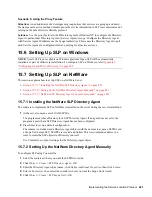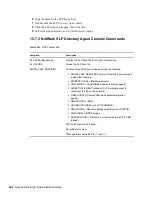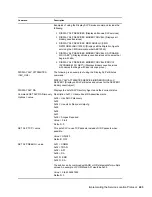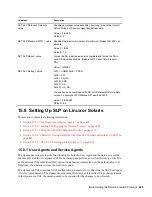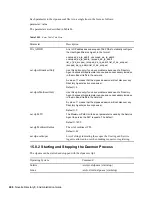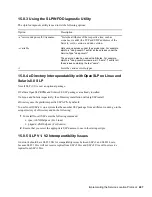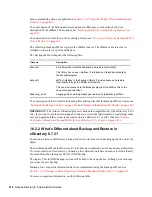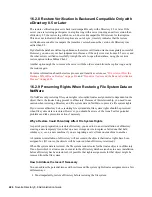
Backing Up and Restoring Novell eDirectory
411
no
vd
ocx
(e
n)
6 Ap
ril 20
07
To allow a quick and complete restore of individual servers (such as after a hardware
failure):
Do a full backup of the eDirectory database regularly (such as weekly).
Do an incremental backup regularly (such as nightly).
Do full and incremental tape backups of the file system shortly after full or incremental
eDirectory database backups are completed.
Backup eMTool writes the backup files to a directory you specify on the server, but has no way
of placing the data directly to tape. File system backup should be set to run after the eDirectory
backup has run, to place the database backup files on tape for safe storage.
Turn on and configure roll-forward logging, if it's necessary in your environment.
You must turn on roll-forward logging for servers that participate in a replica ring. If you don't,
when you try to restore from your backup files you will get errors and the database will not
open. The restore by default won't open a database that shares replicas with other servers unless
it is restored back to the state it was in at the moment before it went down.
In a single-server environment, roll-forward logging is not required for the restore verification
process, but you can use it if you want to be able to restore eDirectory to the moment before it
went down instead of just to the last backup.
Here is a list of the main issues you must address when you turn on roll-forward logging. For
more information, see
Section 16.3, “Using Roll-Forward Logs,” on page 425
.
Specify a new location for the roll-forward logs (don't use the default).
The logs must be local to the server. For fault tolerance, they must not be stored on the
same disk partition/volume or the same storage device as eDirectory. You might want a
separate disk partition/volume just for roll-forward logs.
Document where the roll-forward logs are placed, so that you can find them in the event of
a failure.
To find out the location when the server is healthy, you can look it up in iManager in
Backup Configuration, or in the eMBox Client using the getconfig option. But if the
server has a failure that affects eDirectory (such as a hardware failure), you won't be able
to look up the location of the roll-forward logs.
Monitor disk space on the disk partition/volume where the roll-forward logs are stored, so
that you can prevent it from filling up.
If roll-forward logs cannot be created because no more disk space is available, eDirectory
will stop responding on that server.
Restrict access to where the roll-forward logs are kept, so that unauthorized users cannot
see them.
If a restore is necessary, make sure you re-create the roll-forward log configuration on the
server after the restore is complete. The settings are reset to the default during a restore.
After turning on the roll-forward logs, you must also do a new full backup.
If you use NICI, ensure that your eDirectory backups include NICI security files.
Otherwise, you will not be able to restore the encryption keys, and you won't be able to read
encrypted data. For more information about NICI security, see the
NICI Administration Guide
(http://www.novell.com/documentation/nici27x/index.html)
and the
TID on backing up NICI
files (http://support.novell.com/cgi-bin/search/searchtid.cgi?/10098087.htm)
.
Summary of Contents for EDIRECTORY 8.8 SP2
Page 4: ...novdocx en 6 April 2007...
Page 116: ...116 Novell eDirectory 8 8 Administration Guide novdocx en 6 April 2007...
Page 128: ...128 Novell eDirectory 8 8 Administration Guide novdocx en 6 April 2007...
Page 255: ...256 Novell eDirectory 8 8 Administration Guide novdocx en 6 April 2007...
Page 406: ...408 Novell eDirectory 8 8 Administration Guide novdocx en 6 April 2007...
Page 563: ...566 Novell eDirectory 8 8 Administration Guide novdocx en 6 April 2007...
Page 573: ...576 Novell eDirectory 8 8 Administration Guide novdocx en 6 April 2007...
Page 601: ...604 Novell eDirectory 8 8 Administration Guide novdocx en 6 April 2007...





